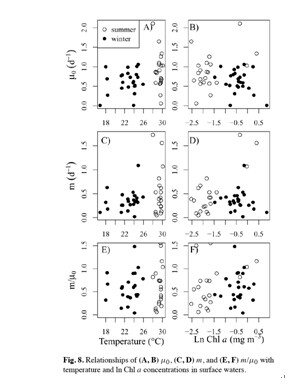Bingzhang Chen, L. Zheng, B. Huang, S. Song,
H. Liu.Biogeosciencesce, 2013. 10, 2775–2785.
We conducted a comprehensive investigation
onthe microzooplankton herbivory effect on phytoplankton inthe northern South
China Sea (SCS) using the seawater dilutiontechnique at surface and deep
chlorophyll maximum(DCM) layers on two cruises (July–August of 2009 and
Januaryof 2010).We compared vertical (surface vs. DCM), spatial(onshore vs.
offshore), and seasonal (summer vs. winter)differences of phytoplankton growth
(μ0) and microzooplanktongrazing rates (m). During summer, both μ0 andm were
significantly higher at the surface than at the DCMlayer, which was below the
mixed layer. During winter, surfaceμ0 was significantly higher than at the DCM,
while mwas not significantly different between the two layers, bothof which
were within the mixed layer. Surface μ0 was, onaverage, significantly higher in
summer than in winter, whileaverage surface m was not different between the two
seasons.There were no cross-shelf gradients of μ0 in summer or wintersurface
waters. In surface waters, μ0 was not correlatedwith ambient nitrate
concentrations, and the effect of nutrient
enrichment on phytoplankton growth was not
pronounced.There was a decreasing trend of m from shelf to basin surfacewaters
in summer, but not in winter. Microzooplanktongrazing effect on phytoplankton
(m/μ0) was relativelysmall in the summer basin waters, indicating a decoupling
ofmicrozooplankton grazing and phytoplankton growth at thistime.On average,
microzooplankton grazed 73% and 65%of the daily primary production in summer
and winter, respectively.

返回

